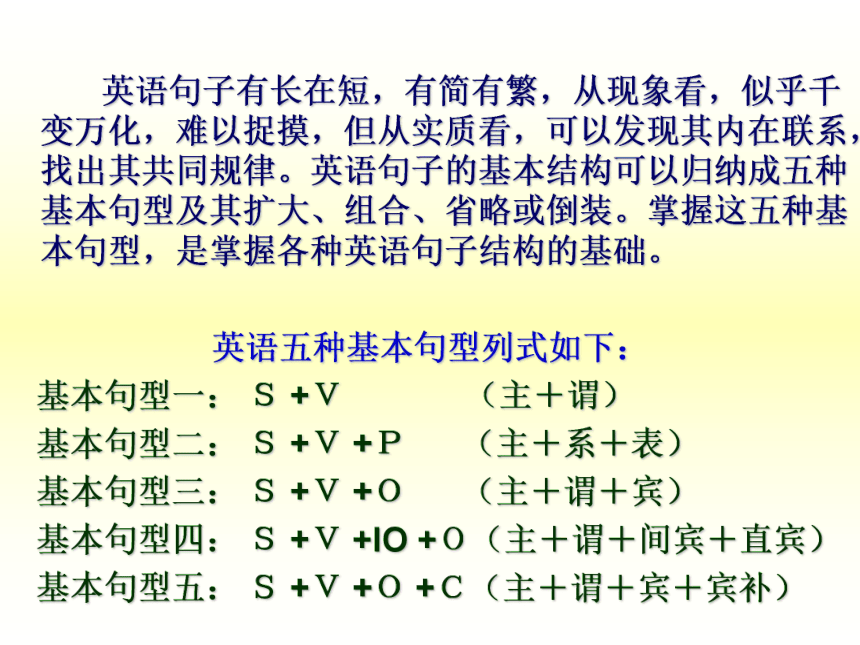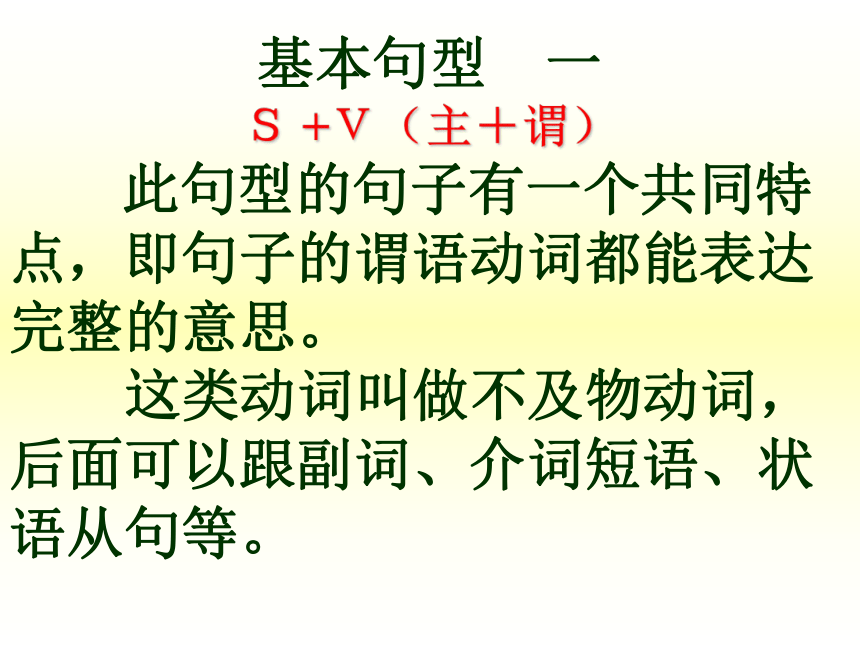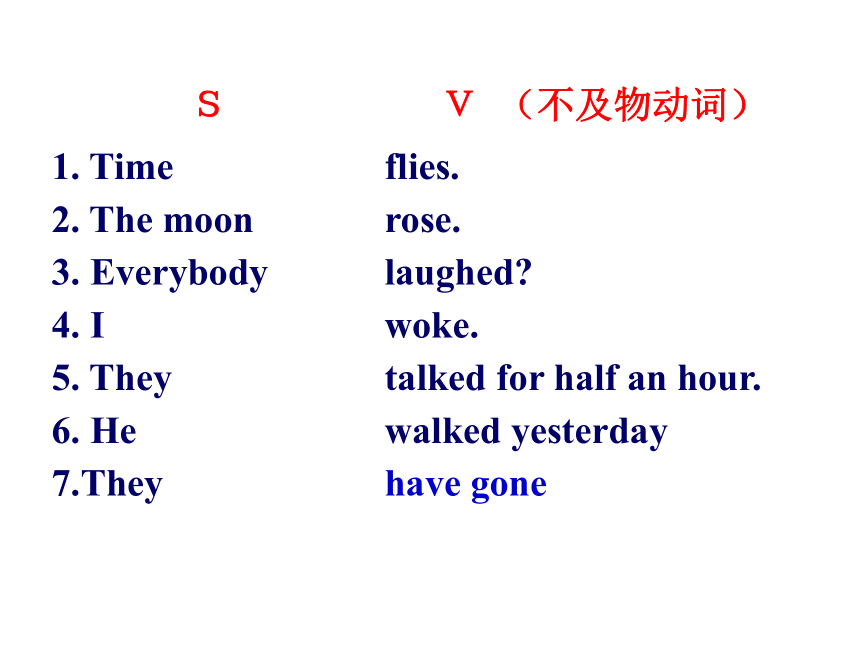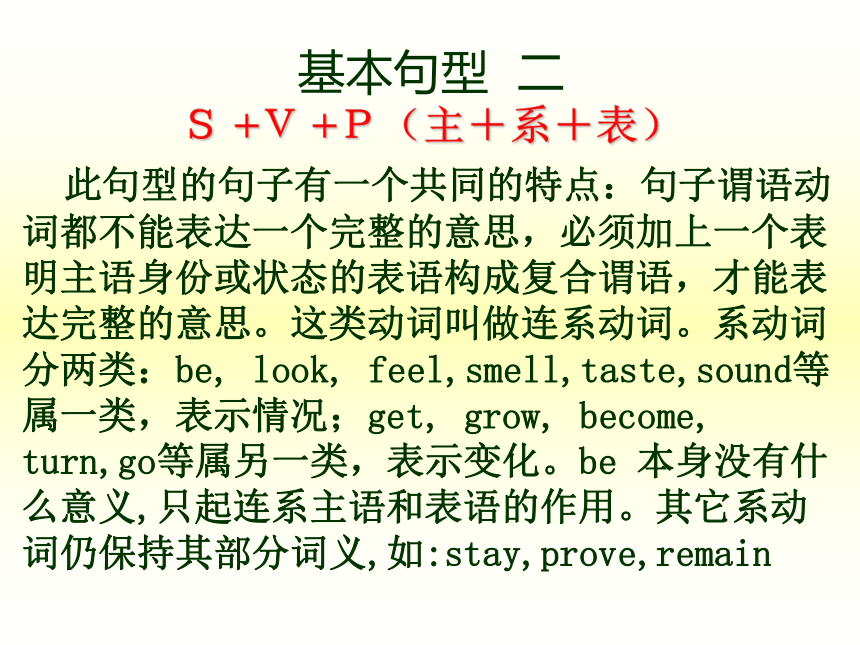2024届高考英语二轮复习:基本结构-五大句型课件(16张PPT)
文档属性
| 名称 | 2024届高考英语二轮复习:基本结构-五大句型课件(16张PPT) |  | |
| 格式 | ppt | ||
| 文件大小 | 341.5KB | ||
| 资源类型 | 教案 | ||
| 版本资源 | 通用版 | ||
| 科目 | 英语 | ||
| 更新时间 | 2023-07-23 18:40:59 | ||
图片预览







文档简介
(共17张PPT)
英语句子有长在短,有简有繁,从现象看,似乎千变万化,难以捉摸,但从实质看,可以发现其内在联系,找出其共同规律。英语句子的基本结构可以归纳成五种基本句型及其扩大、组合、省略或倒装。掌握这五种基本句型,是掌握各种英语句子结构的基础。
英语五种基本句型列式如下:
基本句型一: S +V (主+谓)
基本句型二: S +V +P (主+系+表)
基本句型三: S +V +O (主+谓+宾)
基本句型四: S +V +IO +O(主+谓+间宾+直宾)
基本句型五: S +V +O +C(主+谓+宾+宾补)
基本句型 一
S +V(主+谓)
此句型的句子有一个共同特点,即句子的谓语动词都能表达完整的意思。
这类动词叫做不及物动词,后面可以跟副词、介词短语、状语从句等。
S V (不及物动词)
1. Time
2. The moon
3. Everybody
4. I
5. They
6. He
7.They flies.
rose.
laughed
woke.
talked for half an hour.
walked yesterday
have gone
基本句型 二
S +V +P(主+系+表)
此句型的句子有一个共同的特点:句子谓语动词都不能表达一个完整的意思,必须加上一个表明主语身份或状态的表语构成复合谓语,才能表达完整的意思。这类动词叫做连系动词。系动词分两类:be, look, feel,smell,taste,sound等属一类,表示情况;get, grow, become, turn,go等属另一类,表示变化。be 本身没有什么意义,只起连系主语和表语的作用。其它系动词仍保持其部分词义,如:stay,prove,remain
S V(是系动词) P(表语)
1. This
2. The dinner
3. He
4. Everything
5. He
6. The book
7. The weather
8. His face is
smells(闻)
fell
looks
is
is
became
turned an English dictionary.
good.
happy.
different.
tall and strong.
interesting.
warmer.
red.
基本句型 三
S +V +O(主+谓+宾)
此句型句子的共同特点是:谓语动词都具有实义,都是主语产生的动作,但不能表达完整的意思,必须跟有一个宾语,即动作的承受者,才能使意思完整。这类动词叫做及物动词。
S V(实义动词) O(宾语)
1. Who
2. He
3. He
4. They
5. Danny
6. I
7. He knows
understands
made
ate
likes
want
said the answer
English.
cakes.
some apples.
donuts.
a cup of tea.
"Good morning."
基本句型 四
S +V +IO +O(主+谓+间宾+直宾)
此句型的句子有一个共同特点:谓语动词必须跟有两个宾语才能表达完整的意思。这两个宾语一个是动作的直接承受者,另一个是动作的间接承受者。
通常这一间接承受者用一个介词来连接,当动作的间接承受者在动作的直接承受者之前时,这一介词往往被省略。
S V(及物) o(多指人) O(多指物)
1. She
2. She
3. He
8. He
5. I
6. I
7. I
4. He passed
cooked
brought
bought
showed
gave
told
showed him
her husband
you
her
him
him
me a new dress.
a delicious meal.
a dictionary.
nothing.
my pictures.
a hand.
how to run the machine.
that the bus was late.
基本句型 五
S +V +O +C(主+谓+宾+宾补)
此句型的句子的共同特点是:动词虽然是及物动词,但是只跟一个宾语还不能表达完整的意思,必须加上一个补充成分来补足宾语,才能使意思完整。
S V(及物) O(宾语) C(宾补)
1. We
2. They
3. They
4. They
5. What
6. We
7. He
8. I keep
painted
call
found
makes
saw
asked
saw the table
the door
supper
the house
him
him
me
them clean.
green.
dinner.
dirty.
sad
out.
to come back soon.
getting on the bus.
(二)
1.They work hard.
主 + 谓
2.The flower is dead.
主 + 系 + 表
3.Plants need water.
主 + 谓 + 宾
4.He gives me some seeds.
主 + 谓 + 直宾 + 简宾
5.We should keep the plants in the shade.
主 + 谓 + 宾 + 宾补
6.Many animals live in trees.
主 + 谓
除了基本句型的成分不变外,通常是在这些成分的前面或后面增加一些修饰语而加以扩大。这些修饰语可以是单词(主要是形容词、副词和数词),也可以是各种类型的短语(主要是介词短语、不定式短语和分词短语)。下面以基本句型五(v+o+o.c)为例:
We found the hall full.
我们发现礼堂坐满了。
We found the great hall full of students and teachers.
我们发现大礼堂坐满了学生和教师。
We found the great hall full of students and teachers
listening to an important report.
我们发现大礼堂坐满了学生和教师,在听一个重要报告。
We found the great hall full of students and teachers
listening to an important report made by a comrade from the People's Daily on current affairs in East Europe.
我们发现大礼堂坐满了学生和教师,在听人民日报的一位同志作有关东欧局势的重要报告。
不同的动词使用的句型也不尽一样,因此在学习动词时,应掌握动词的类型。以 get 为例:
He's getting angry. (S V P)
He got through the window. (S V O)
You'll get a surprise. (S V O)
He got his shoes and socks wet. (S V O C)
He got himself into trouble. (S V O C)
He got her a splendid present. (S V 0 O)
在句子中词类和词的位置也影响句子的句型和意思:
I found the book easily.
我很容易地找到了这本书。
I found the book easy.
我觉得这本书很容易。
I have to do something. 我得做点事。
I have something to do. 我有点事做。
英语句子有长在短,有简有繁,从现象看,似乎千变万化,难以捉摸,但从实质看,可以发现其内在联系,找出其共同规律。英语句子的基本结构可以归纳成五种基本句型及其扩大、组合、省略或倒装。掌握这五种基本句型,是掌握各种英语句子结构的基础。
英语五种基本句型列式如下:
基本句型一: S +V (主+谓)
基本句型二: S +V +P (主+系+表)
基本句型三: S +V +O (主+谓+宾)
基本句型四: S +V +IO +O(主+谓+间宾+直宾)
基本句型五: S +V +O +C(主+谓+宾+宾补)
基本句型 一
S +V(主+谓)
此句型的句子有一个共同特点,即句子的谓语动词都能表达完整的意思。
这类动词叫做不及物动词,后面可以跟副词、介词短语、状语从句等。
S V (不及物动词)
1. Time
2. The moon
3. Everybody
4. I
5. They
6. He
7.They flies.
rose.
laughed
woke.
talked for half an hour.
walked yesterday
have gone
基本句型 二
S +V +P(主+系+表)
此句型的句子有一个共同的特点:句子谓语动词都不能表达一个完整的意思,必须加上一个表明主语身份或状态的表语构成复合谓语,才能表达完整的意思。这类动词叫做连系动词。系动词分两类:be, look, feel,smell,taste,sound等属一类,表示情况;get, grow, become, turn,go等属另一类,表示变化。be 本身没有什么意义,只起连系主语和表语的作用。其它系动词仍保持其部分词义,如:stay,prove,remain
S V(是系动词) P(表语)
1. This
2. The dinner
3. He
4. Everything
5. He
6. The book
7. The weather
8. His face is
smells(闻)
fell
looks
is
is
became
turned an English dictionary.
good.
happy.
different.
tall and strong.
interesting.
warmer.
red.
基本句型 三
S +V +O(主+谓+宾)
此句型句子的共同特点是:谓语动词都具有实义,都是主语产生的动作,但不能表达完整的意思,必须跟有一个宾语,即动作的承受者,才能使意思完整。这类动词叫做及物动词。
S V(实义动词) O(宾语)
1. Who
2. He
3. He
4. They
5. Danny
6. I
7. He knows
understands
made
ate
likes
want
said the answer
English.
cakes.
some apples.
donuts.
a cup of tea.
"Good morning."
基本句型 四
S +V +IO +O(主+谓+间宾+直宾)
此句型的句子有一个共同特点:谓语动词必须跟有两个宾语才能表达完整的意思。这两个宾语一个是动作的直接承受者,另一个是动作的间接承受者。
通常这一间接承受者用一个介词来连接,当动作的间接承受者在动作的直接承受者之前时,这一介词往往被省略。
S V(及物) o(多指人) O(多指物)
1. She
2. She
3. He
8. He
5. I
6. I
7. I
4. He passed
cooked
brought
bought
showed
gave
told
showed him
her husband
you
her
him
him
me a new dress.
a delicious meal.
a dictionary.
nothing.
my pictures.
a hand.
how to run the machine.
that the bus was late.
基本句型 五
S +V +O +C(主+谓+宾+宾补)
此句型的句子的共同特点是:动词虽然是及物动词,但是只跟一个宾语还不能表达完整的意思,必须加上一个补充成分来补足宾语,才能使意思完整。
S V(及物) O(宾语) C(宾补)
1. We
2. They
3. They
4. They
5. What
6. We
7. He
8. I keep
painted
call
found
makes
saw
asked
saw the table
the door
supper
the house
him
him
me
them clean.
green.
dinner.
dirty.
sad
out.
to come back soon.
getting on the bus.
(二)
1.They work hard.
主 + 谓
2.The flower is dead.
主 + 系 + 表
3.Plants need water.
主 + 谓 + 宾
4.He gives me some seeds.
主 + 谓 + 直宾 + 简宾
5.We should keep the plants in the shade.
主 + 谓 + 宾 + 宾补
6.Many animals live in trees.
主 + 谓
除了基本句型的成分不变外,通常是在这些成分的前面或后面增加一些修饰语而加以扩大。这些修饰语可以是单词(主要是形容词、副词和数词),也可以是各种类型的短语(主要是介词短语、不定式短语和分词短语)。下面以基本句型五(v+o+o.c)为例:
We found the hall full.
我们发现礼堂坐满了。
We found the great hall full of students and teachers.
我们发现大礼堂坐满了学生和教师。
We found the great hall full of students and teachers
listening to an important report.
我们发现大礼堂坐满了学生和教师,在听一个重要报告。
We found the great hall full of students and teachers
listening to an important report made by a comrade from the People's Daily on current affairs in East Europe.
我们发现大礼堂坐满了学生和教师,在听人民日报的一位同志作有关东欧局势的重要报告。
不同的动词使用的句型也不尽一样,因此在学习动词时,应掌握动词的类型。以 get 为例:
He's getting angry. (S V P)
He got through the window. (S V O)
You'll get a surprise. (S V O)
He got his shoes and socks wet. (S V O C)
He got himself into trouble. (S V O C)
He got her a splendid present. (S V 0 O)
在句子中词类和词的位置也影响句子的句型和意思:
I found the book easily.
我很容易地找到了这本书。
I found the book easy.
我觉得这本书很容易。
I have to do something. 我得做点事。
I have something to do. 我有点事做。
